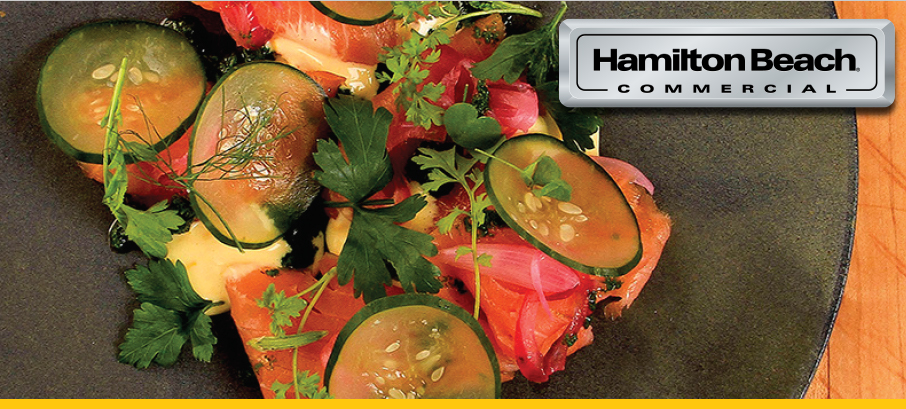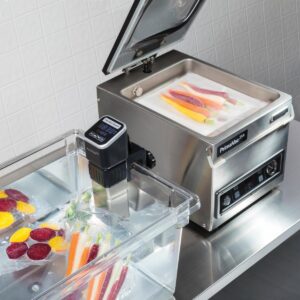
Courtesy SEFA Marketing Department
Reducing kitchen waste and keeping food budgets lean have always been big challenges for foodservice professionals. Now more than ever, it’s essential to do both. Supply chains are being disrupted. Customers’ behavior is becoming harder to predict. Nevertheless, chefs and operators carry on the heroic work of keeping people fed in restaurant, healthcare, and institutional kitchens. Hamilton Beach Commercial is here to help. With the help of expert chefs, they’ve found effective strategies for getting the most out of every ingredient.

Process food the second it’s delivered
In the best of times, it’s tough for kitchen staff to drop everything to deal with incoming deliveries. Now, when your team is understaffed and overwhelmed, it’s even tougher. But, the best thing you can do to save money right now is “take care of your produce when it first comes in,” says Sandra D. Ratcliff, CEC, a long-time chef and director of healthcare sales for The Hansen Group.
Her advice: Designate a team member to immediately deal with deliveries, even if you’re short-staffed. The cost savings will easily pay for that extra person. When a case of iceberg lettuce arrives, don’t leave it in the dirty cardboard box that’s been sitting in a farm field. Wash that lettuce and vacuum-seal it—“You’ve automatically gotten an extra three weeks out of a product.” The same goes for other ingredients: fresh fish, meat, cheese, etc.
Another benefit of vacuum-sealing is visibility. When stored in cardboard or other opaque packaging, food is often forgotten and left to rot in the walk-in. Once vacuum-sealed, it’s easier to see and use. Just remember that it’s essential to follow food safety guidelines for vacuum-packed foods, and train kitchen staff in safe handling practices.
Increase order sizes
In the face of so much uncertainty, it seems counterintuitive to order larger quantities of food. That’s exactly what Ratcliff recommends, however, especially because many restaurant supply companies have cut back their deliveries to just one or two per week. You can save a significant amount of money on food if you order large quantities of ingredients, then process and portion them. Get the 10-pound block of cheese, then cut 1-pound portions and vacuum-seal each one for long-lasting freshness. Order 50 pounds of flour and 30 pounds of dried beans, then measure out the increments needed for specific dishes and vacuum-seal.
Order ingredients that have the widest range of uses
Get the most out of your food inventory by selecting super-versatile ingredients. Review your menu to identify which products can be processed and repurposed across multiple applications. Two examples include chicken and fish, both of which can be prepared in various ways to build out your menu. Proteins like these can be portioned precisely, seasoned or marinated, and then stored for optimum quality using a vacuum chamber sealer.

Prevent prepared food from going to waste
Calibrating food production is tricky when demand is unpredictable. But, now’s the time to be conscious of even the smallest amount of food waste, Ratcliff says, because it adds up. She once oversaw foodservice for a healthcare system with 65 locations. One of those—an 82-bed nursing facility—was notorious for going over its food budget by up to $2,700 every month. When she investigated, she found the kitchen was preparing an extra 11 meals per mealtime, every day, just in case they were needed. With PPD food costs around $7, the system would have lost nearly $1.8 million per year if every location did the same, Ratcliff calculated.
The solution? Educating the staff on batch cooking and vacuum-sealing extra portions that could be cooked quickly to meet resident requests. This strategy can be applied not only to healthcare settings, but also to restaurants, which might get 50 takeout orders one evening and 10 the next. Meals can be perfectly cooked sous vide, ensuring food safety and preventing overcooking, and served as needed.
Revive wilting greens
Herbs and baby greens are among the most fragile of ingredients—and unless you grow them on-site, they can be in short supply. Chef Andrew Manning, of acclaimed fine-dining restaurant Longoven in Richmond, Virginia, suggests using a chamber vacuum sealer to hydroshock sensitive greens and bring them back to life.
Place greens in a wide, shallow container. Cover them with paper towels, then add ice and cold water. Run the vacuum cycle twice, which removes air from the greens and forces in cold water. The result: rejuvenated herbs that stay crisp for days.